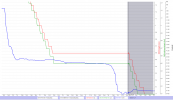This had nothing to do with any imaginary interference with GPS.
Agreed.
The only reason I even mentioned RTH was because I was looking right at the drone at the time and the sound of the waterfall was quite loud, so it took me a moment to even notice the beeping sound. Wondering what that was all about, I glanced down at the screen and didn't take the time to read and digest the red message. I just automatically hit Cancel to stop whatever it was doing because I had just then realized the Mini was descending by itself.
My initial thought at the time was that it had gone into low-battery RTH, and because it was within 20m of the Home location it was just straight down landing instead. That needed to be cancelled right away.
At the 4m 1s time mark the VPS altitude suddenly comes alive reporting 3.6ft height above ground, while it's still 27.9ft above me. At 4m 3.
2s, as I'm descending at
25m (25ft) above me, the VPS is suddenly reporting 2ft AGL and then it goes into "Forced Landing".
I just noticed I mis-typed that. It was 25ft, not 25m.
The Mini was still 25ft higher than my vantage point, which itself was about 30ft above the water. But, by the time I eventually got around to cancelling the auto-landing, it had already descended 15ft (4.6m).
I stopped it when it was still 10ft higher than me, or 40ft above the water. So there was no actual danger. Just confusion.
I was bringing the drone back down for a landing at the time, so maybe I actually did have the throttle stick held full down at the time. I could understand how, if the VPS.height is showing only 2ft AGL while the throttle stick is being held full down, that would trigger the auto-land sequence as normal. So maybe it saw a spray of mist that close below it? I dunno.
If there had actually been something that close only 2ft under the drone, as recorded by the VPS height, how did the drone manage to descend 15ft without hitting anything before I got around to cancelling the auto-landing? It's curious.



















